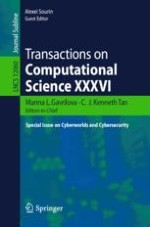The LNCS journal Transactions on Computational Science reflects recent developments in the field of Computational Science, conceiving the field not as a mere ancillary science but rather as an innovative approach supporting many other scientific disciplines. The journal focuses on original high-quality research in the realm of computational science in parallel and distributed environments, encompassing the facilitating theoretical foundations and the applications of large-scale computations and massive data processing. It addresses researchers and practitioners in areas ranging from aerospace to biochemistry, from electronics to geosciences, from mathematics to software architecture, presenting verifiable computational methods, findings, and solutions, and enabling industrial users to apply techniques of leading-edge, large-scale, high performance computational methods.
This, the 36th issue of the Transactions on Computational Science, is devoted to the area of Cyberworlds and Cybersecurity. The first four papers constitute extended versions of selected papers presented at the 2018 International Conference on Cyberworlds, CW 2018. A further two papers were accepted following an open Call for Papers and cover the areas of fast 3D segmentation using geometric surface features and nature-inspired optimization for face recognition.
